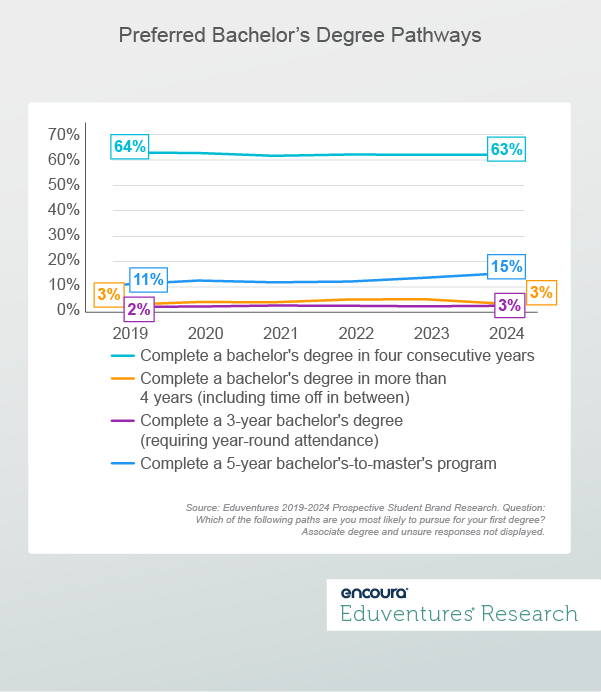Colleges have long offered students a pathway to accelerated bachelor’s degree completion, but that pathway has always looked the same: cram four years of study into three years of time. Given the rigorous academic lift required, this can be a daunting task for many students—or even outright inaccessible to students who need to work or handle familial responsibilities.
As currently designed, the traditional three-year bachelor’s pathway is simply not realistic for most. But as of April, new bachelor’s programs in the market—those that truncate credit requirements instead of just time—seek to shake up the three-year bachelor’s degree.
Small Audience and Limited Scale
The idea of a three-year bachelor’s degree is not new.
Higher education leaders, economists, and politicians have all touted the idea as a means of addressing the climbing cost of higher education. In 2009, former senator Lamar Alexander, longtime chair of the U.S. Senate Committee on Health, Education, Labor, and Pensions, urged college leaders to embrace the three-year bachelor’s degree idea, likening it to that of a fuel-efficient car vs. its gas guzzling equivalent (the traditional four-year pathway).
But as colleges and universities have attempted to do so, they’ve all remained tethered to the 120-credit hour bachelor’s requirement, experimenting only with time to completion rather than credits to completion. This has resulted in limited interest, which is confirmed by the Eduventures Prospective Student Brand Research™.
Figure 1 shows the pathway preferences among college-bound high school students between 2019 and 2024.

Figure 1
As Figure 1 shows, interest in the typical three-year bachelor’s pathway has never surpassed 3% of prospects. Also note, however, that the response specifically highlights the need for year-round attendance—the current reality for these programs. The survey data does not measure interest if fewer credits, and less time, are involved.
Additionally, while there is no official data point tracking these accelerated pathways, National Student Clearinghouse data reveals that just 8% of first-time, full-time undergraduates at four-year public institutions and 11% from four-year private institutions graduate in three years. Given that many four-year schools offer associate degree programs (over 13,000 such programs as of 2022), however, the true three-year completion rate of bachelor’s programs is likely much smaller.
A New Approach
What would interest in a three-year bachelor’s degree program look like if completion did not require year-round attendance? BYU-Pathway Worldwide, a partnership between Brigham Young University-Idaho and Ensign College, is about to find out.
Earning accreditor approval in Fall 2023, BYU-Pathway Worldwide becomes the first provider of accredited and, critically, truncated three-year bachelor’s programs. This means that the seven three-year bachelor’s degree programs approved require only 90-94 credits for completion—a reduction of up to 25%.
Having officially launched in April 2024, here’s what we know about these programs:
- Seven approved programs. Offered fully online, these programs are in applied business management, applied health, communication, family and human services, information technology, professional studies, and software development.
- Electives and general education requirements. The truncated nature of these programs means that electives have largely been removed from the programs. At the same time, each program requires a set of general education requirements (totaling 47 credits) that includes courses across the natural, social, and physical sciences, arts, humanities, math, career success, religion, and more. Notably, the general education courses for each program are “recommended” indicating some degree of choice.
This latter feature suggests that the broad-based nature of the traditional four-year bachelor’s degree, providing a well-rounded education to completers, is not completely sacrificed in the effort to reduce time through credits. This addresses a sticking point for critics of the truncated three-year bachelor’s concept.
Another significant component of these programs is their organization into laddered certificates. Figure 2 provides a snapshot of a degree program structure and courses using the Information Technology program as an example.
Figure 2.
BYU-Pathway Worldwide: Information Technology 3-Year Bachelor’s Degree
Laddered Certificate Pathway (94 total credits)
|
Certificate 1: Technical Support Engineer (16 credits) |
Certificate 2: IT Fundamentals (15 credits) |
Certificate 3: Systems Administration (15 credits) |
|
|
|
|
General Education Courses: 19 general education courses (~47 credits) ranging from 1-3 credits including quantitative reasoning, interpersonal communications, microeconomics, history of fine arts, and an internship. These courses begin upon completion of the first certificate. |
||
Source: BYU-Pathway Worldwide website.
The laddered certificate approach, as positioned on the website, was designed to “lead to better job opportunities,” placing career at the center of program design and allowing students to seek new employment during their courses of study with demonstrable skills. It also suggests that these programs have been designed with possible “off-ramps” for students. For example, if students must pause their educations for unforeseen reasons, they may still have a certificate—or three—to point to on their resumes.
Apart from the shortened length of these programs, BYU Pathway also stresses other support features like access to mentors, student advising tailored to online learning, weekly gatherings in a student’s first year, and an online help center.
The Bottom Line
While this Wake-Up Call is not intended as an endorsement of BYU-Pathway Worldwide at such an early stage, it is an endorsement of an innovative approach—a bold attempt at reimagining the traditional, four-year bachelor’s degree.
In Eduventures’ view, there is no time like the present for higher education leaders to think outside of the box—the right path forward isn’t necessarily the way things have always been done. Higher education is under tremendous pressure. Looming demographic shortfalls, stagnant participation rates, declining value perception, questions over outcomes, and pressure on the degree wealth premium merge to create an unprecedented wave of challenges pointing to the need for real product innovation.
Is a three-year bachelor’s degree the right tool to help meet the moment? Time will tell. But it does showcase an attempt to lessen the cost of higher education in a real, tangible way. The approach may not be for everyone, but it could become one of many offerings designed to meet the diverse needs of students.
Even if successful, however, the BYU Pathway initiative may be limited by the scope of its audience. The 100% online nature of its programs, and its positioning, signal it is targeting adult undergraduates—a market segment that is much smaller than the traditional-aged undergraduate cohort and one that has shrunk by over one-third since the market highs of 2010.
The real test may be for schools seeking to introduce this concept to traditional-aged undergraduates.
While some have tried, accreditors have traditionally been hesitant to approve such a divergent approach.
Recent reporting from Inside Higher Ed, however, indicates a potential thaw on this front. In an April College-in-3 Exchange meeting (a working group encouraging colleges to build faster and cheaper degree programs), officials from the Higher Learning Commission stated that, “beginning in September, the agency will consider granting approval to any institution seeking to offer a ‘reduced-credit bachelor’s degree’ in any program.”
From an accreditation perspective, this represents a sea change in the three-year bachelor’s landscape. Coupled with other recent developments—like Indiana’s state legislature approval of a measure that, if signed into law, would require all four-year publics in the state to develop a three-year pathway—we must consider the three-year bachelor’s experiment to be officially heating up.


